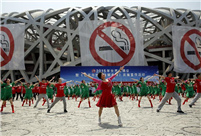

 |
| Pollution has turned a soda lake red in a pasturing area of Ordos, North China's Inner Mongolia Autonomous Region. [Photo/ Weibo account of The Beijing News] |
BEIJING, April 16 -- China on Thursday issued a plan to intensify the fight against water pollution.
The Action Plan for Water Pollution Prevention and Control aims to reduce pollutants, improve drinking water and promote water conservation, according to the State Council, China's cabinet.
Aquatic ecosystems have been severely damaged in many parts of China, threatening public health and economic development. Targets for improvements by the end of 2020 include reducing the amount of severely polluted water and containing groundwater contamination.
Specifically, the plan said more than 70 percent of the water in the seven major river valleys, including the Yangtze and Yellow rivers, should be in good condition by 2020. The same target is set for offshore areas.
By the end of 2030, more than 75 percent of the water in the seven major river valleys should be clear, with dark and odorous water in urban areas eliminated.
Small factories in sectors such as paper, insecticides and tanning will be shut down by the end of 2016, as they are weak in environmental protection. Bigger projects in these sectors must update their technology to meet emission requirements.
Starting in 2016, a blacklist will name businesses that exceed their pollutant quotas, with severe violators risking the possibility of closure.
The document also calls for preservation of wetlands, mangrove swamps and coral reefs. Aquatic reserves should be better protected, it said.
Pollution checks will be conducted every year and the results will be part of performance reviews for provincial officials. The distribution of the funds will also depend on the results.
Officials who fail to handle water pollution incidents effectively and those who fabricate statistics will be held accountable.
The 238 concrete measures of the action plan have been assigned to departments and offices, which will receive punishment if they fail to achieve the goal, industry experts said.
Fu Tao, director of the water policy research center at Tsinghua University, told Xinhua that the development of sewage treatment plants lags far behind city development, with a great amount of polluted water discharged into rivers and lakes.
"China should build more efficient sewage treatment plants and lay out a network of pipelines to collect polluted water to increase reuse," Fu said.
According to the plan, China will channel more efforts to increase the quality of drinking water, and the usage rate for recycled water should be increased to at least 20 percent by 2020.
In the Beijing-Tianjin-Hebei region, the recycled water usage rate should exceed 30 percent, the plan said.
The Beijing-Tianjin-Hebei region is in urgent need of water and suffers severe water pollution.
According to figures provided by the Beijing water conservancy authority, Beijing has been increasing use of recycled water, and in 2014, the volume of recycled water reached 860 million cubic meters.
The action plan also urged an increase in water source quality.
"The quality of water sources is deteriorating," said Wang Hao, an academician with the Chinese Academy of Engineering. "To ensure safe drinking water, we must focus on treatment of water sources," Wang added.
 J-11 fighters in air exercise
J-11 fighters in air exercise Beauties dancing on the rings
Beauties dancing on the rings Attendants-to-be join Mr. & Miss Campus Contest
Attendants-to-be join Mr. & Miss Campus Contest Beijing's toughest anti-smoking law takes effect
Beijing's toughest anti-smoking law takes effect Family lives in cave for about 50 years in SW China
Family lives in cave for about 50 years in SW China PLA soldiers operating vehicle-mounted guns in drill
PLA soldiers operating vehicle-mounted guns in drill Blind carpenter in E China's Jiangxi
Blind carpenter in E China's Jiangxi China hosts overseas disaster relief exercise for the first time
China hosts overseas disaster relief exercise for the first time 20 pairs of twins who will become flight attendants in Sichuan
20 pairs of twins who will become flight attendants in Sichuan Obama is sowing discontent in S.China Sea
Obama is sowing discontent in S.China Sea Rescuers work through night to reach cruise ship survivors
Rescuers work through night to reach cruise ship survivors Driving through limbo
Driving through limbo Facing down MERS
Facing down MERSDay|Week